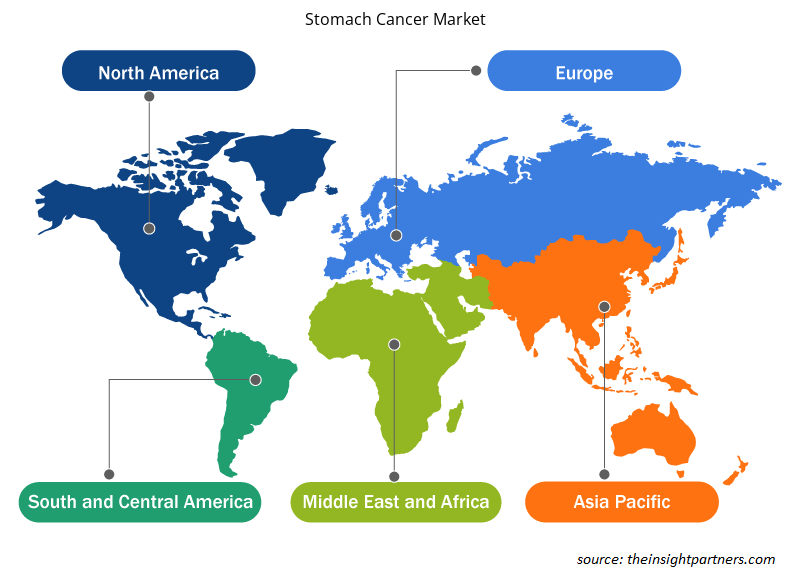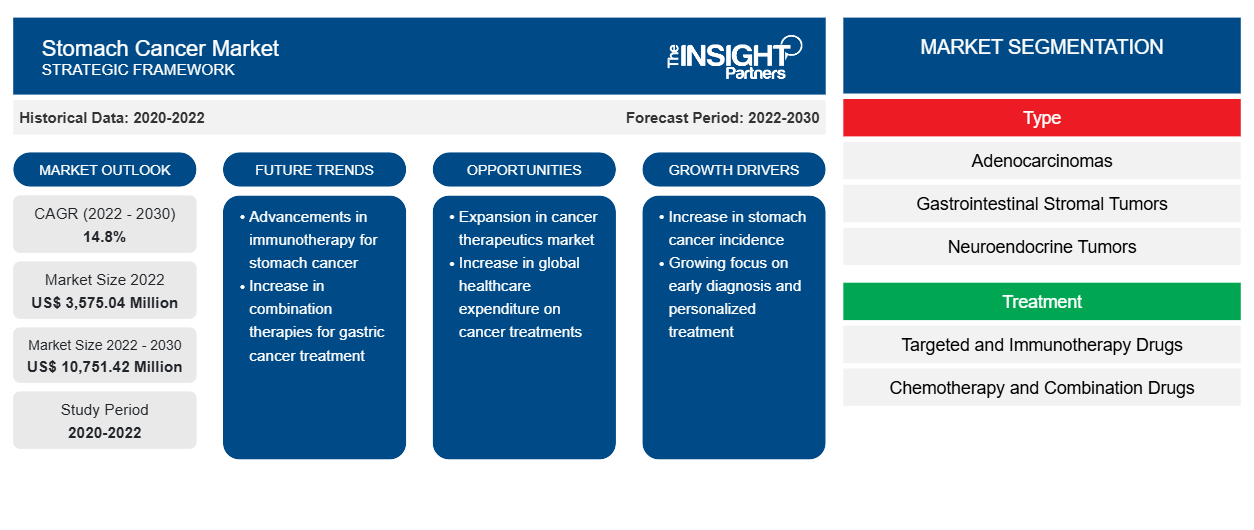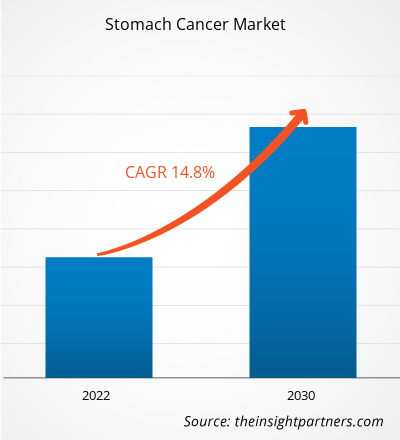[Forschungsbericht] Der Markt für Magenkrebs soll von 3.575,04 Millionen US-Dollar im Jahr 2022 auf 10.751,42 Millionen US-Dollar im Jahr 2030 wachsen; für den Zeitraum 2022–2030 wird eine durchschnittliche jährliche Wachstumsrate (CAGR) von 14,8 % erwartet.
Markteinblicke und Analystenansichten:
Magenkrebs, auch Magenkarzinom genannt, wird durch das abnormale und unkontrollierte Wachstum der bösartigen Zellen im Magen verursacht. Zu den Risikofaktoren, die das Risiko von Magenkrebs erhöhen, gehören Alter und Ernährung. Verdauungsstörungen, Magenbeschwerden, Appetitlosigkeit, Sodbrennen und Gewichtsverlust sind alles Symptome von Magenkrebs. Zur Behandlung von Magenkrebs werden verschiedene Ansätze eingesetzt, wie Chemotherapie, Strahlentherapie und Immuntherapie. Das Wachstum des Magenkrebsmarktes wird von Faktoren wie der zunehmenden Häufigkeit von Magenkrebs, Fortschritten in der Behandlung, einschließlich Chemotherapie, Chirurgie und gezielten Therapien, sowie laufenden Forschungs- und Entwicklungsbemühungen zur Verbesserung der Patientenergebnisse beeinflusst. Mit der zunehmenden Betonung von Frühdiagnose und personalisierten Behandlungsansätzen wird erwartet, dass der Markt für Magenkrebsbehandlungen in Zukunft weiter wachsen wird.
Wachstumstreiber:
Unternehmen im Gesundheitsmarkt führen verschiedene Forschungs- und Entwicklungsaktivitäten durch, um innovative Behandlungen für Magenkrebs einzuführen. Darüber hinaus werden die Behandlungen in klinischen Studien evaluiert , und es werden auch ständig neue Ansätze entwickelt und in klinischen Studien untersucht. Nachfolgend sind einige der Produkte aufgeführt, die sich in der Pipeline befinden:
- Im Dezember 2022 schloss Zhejiang Doer Biologics Co., Ltd. eine Kooperationsvereinbarung für klinische Studien mit Merck & Co., Inc. ab, um den Anti-Claudin18.2-Antikörper DR30303 von Doer Bio in Kombination mit der Anti-PD-1-Therapie KEYTRUDA (Pembrolizumab) von Merck bei Patienten mit Magen- oder gastroösophagealem Übergangskrebs zu untersuchen. Im Rahmen der Vereinbarung führte Doer Bio eine experimentelle Studie auf der Grundlage eines einvernehmlich vereinbarten und finalisierten Protokolls durch, um die Sicherheit und Wirksamkeit von DR30303 in Kombination mit KEYTRUDA bei Patienten mit Claudin18.2-positivem, lokal fortgeschrittenem, nicht resektablem oder metastasiertem Magen- oder gastroösophagealem Übergangskrebs zu untersuchen.
- Im November 2022 gab Triumvira Immunologics präklinische Daten zu seinen experimentellen TAC-T-Zelltherapien CLDN18.2-TAC T und GUCY2C-TAC T sowie Daten zu HER2-spezifischen TAC-T-Produkten bekannt. Das Unternehmen präsentierte die aktualisierten Daten zu seinem neuartigen T-Zell-Antigenkoppler (TAC)-T-Zellkandidaten, der auf Claudin 18.2 abzielt und zur Behandlung von Magenkrebs eingesetzt werden soll.
- Im September 2022 gab Nuvectis Pharma, Inc. positive Daten für NXP800 in einem präklinischen Xenograft-Modell eines ARID1a-mutierten Magenkarzinoms bekannt. Die Tumorvolumina wurden 28 Tage lang gemessen, nachdem die Mäuse in jeder Gruppe entweder mit einem Vehikel oder einer NXP800-Behandlung behandelt worden waren. Tumorregression und signifikante Hemmung des Tumorwachstums waren die Ergebnisse der NX800-Behandlung im Vergleich zur Kontrollgruppe.
Daher trägt die steigende Zahl klinischer Studien dazu bei, die Verfügbarkeit von Magenkrebsbehandlungen weltweit zu erhöhen, was sich wiederum positiv auf das Wachstum des Magenkrebsmarktes auswirkt.
Passen Sie diesen Bericht Ihren Anforderungen an
Sie erhalten kostenlos individuelle Anpassungen an jedem Bericht, einschließlich Teilen dieses Berichts oder einer Analyse auf Länderebene, eines Excel-Datenpakets sowie tolle Angebote und Rabatte für Start-ups und Universitäten.
- Holen Sie sich die wichtigsten Markttrends aus diesem Bericht.Dieses KOSTENLOSE Beispiel umfasst eine Datenanalyse von Markttrends bis hin zu Schätzungen und Prognosen.
Berichtssegmentierung und -umfang:
Der Magenkrebsmarkt ist nach Art, Behandlung, Verabreichungsweg, Vertriebskanal und Geografie segmentiert.Basierend auf der Art wird der Magenkrebsmarkt in Adenokarzinome, gastrointestinale Stromatumoren, neuroendokrine Tumoren, Lymphome und andere unterteilt. Basierend auf der Behandlung wird der Magenkrebsmarkt in zielgerichtete und Immuntherapiemedikamente, Chemotherapie und Kombinationsmedikamente und andere unterteilt. Der Magenkrebsmarkt wird nach Verabreichungsweg in oral, parenteral und andere unterteilt. In Bezug auf den Vertriebskanal wird der Magenkrebsmarkt in Krankenhausapotheken, Einzelhandelsapotheken und Online-Apotheken unterteilt. Geografisch ist der Magenkrebsmarkt in Nordamerika (USA, Kanada und Mexiko), Europa (Frankreich, Deutschland, Großbritannien, Spanien, Italien und der Rest von Europa), Asien-Pazifik (China, Indien, Japan, Australien, Südkorea und der Rest des Asien-Pazifik-Raums), den Nahen Osten und Afrika (Saudi-Arabien, die Vereinigten Arabischen Emirate, Südafrika und der Rest des Nahen Ostens und Afrikas) und Süd- und Mittelamerika (Brasilien, Argentinien und der Rest von Süd- und Mittelamerika) unterteilt.
Segmentanalyse:
Der Magenkrebsmarkt wird nach Typ unterteilt inAdenokarzinome, gastrointestinale Stromatumoren, neuroendokrine Tumoren, Lymphome und andere. Das Segment Adenokarzinome hatte 2022 einen bedeutenden Marktanteil und wird voraussichtlich zwischen 2022 und 2030 die höchste CAGR auf dem Magenkrebsmarkt verzeichnen.
Basierend auf der Behandlung wird der Magenkrebsmarkt in zielgerichtete und Immuntherapiemedikamente unterteilt,Chemotherapie- und Kombinationspräparate und andere. Im Jahr 2022 hielt das Segment Chemotherapie- und Kombinationspräparate einen erheblichen Marktanteil. Das Segment zielgerichtete und Immuntherapie-Medikamente dürfte im Zeitraum 2022–2030 die höchste durchschnittliche jährliche Wachstumsrate auf dem Magenkrebsmarkt verzeichnen.
Basierend auf der Verabreichungsmethode ist der Magenkrebsmarkt in oral, parenteral und andere unterteilt. Im Jahr 2022 hielt das orale Segment einen erheblichen Marktanteil und es wird erwartet, dass es im Zeitraum 2022–2030 die schnellste CAGR verzeichnet.
Basierend auf dem Vertriebskanal wird der Magenkrebsmarkt in Krankenhausapotheken, Einzelhandelsapotheken und Online-Apotheken unterteilt. Das Segment der Krankenhausapotheken hielt 2022 einen erheblichen Marktanteil und wird voraussichtlich zwischen 2022 und 2030 die höchste durchschnittliche jährliche Wachstumsrate verzeichnen.
Regionale Analyse:
Der Magenkrebsmarkt ist hauptsächlich in Nordamerika, Europa, Asien-Pazifik, Süd- und Mittelamerika sowie den Nahen Osten und Afrika unterteilt. Im Jahr 2022 eroberte Nordamerika einen bedeutenden Marktanteil. Im Jahr 2022 hielten die USA den größten Marktanteil in der Region. Das Marktwachstum in Nordamerika wird auf die zunehmende Verbreitung von Magenkrebs, die zunehmende Einführung gezielter Krebstherapien und die Zugänglichkeit fortschrittlicher Technologien in Krebsforschungs- und -behandlungszentren zurückgeführt. Die American Cancer Society geht davon aus, dass im Jahr 2023 etwa 26.500 neue Fälle von Magenkrebs (15.930 bei Männern und 10.570 bei Frauen) diagnostiziert werden. Etwa 11.130 Todesfälle (6.690 bei Männern und 4.440 bei Frauen) werden auf Magenkrebs zurückzuführen sein. Nordamerika ist im Hinblick auf die Zugänglichkeit fortschrittlicher technologischer Behandlungsmöglichkeiten zur Reduzierung von Krebs gut entwickelt, und die Unternehmen arbeiten hart daran, mit den bekannten Akteuren in der Region zu konkurrieren.
Darüber hinaus wird davon ausgegangen, dass die zunehmenden Unternehmensaktivitäten bei der Durchführung klinischer Studien zur Entwicklung wirksamer Medikamente für Patienten mit Magenkrebs sowie die zunehmenden Produkteinführungen und -zulassungen das Marktwachstum in der Region ankurbeln werden. Im April 2021 genehmigte die Food and Drug Administration (FDA) Bristol Myers Squibbs Opdivo in Kombination mit Fluoropyrimidin und platinhaltiger Chemotherapie zur Behandlung von Patienten mit fortgeschrittenem oder metastasiertem Magenkrebs und Speiseröhrenadenokarzinom. Daher werden solche Faktoren wahrscheinlich das Marktwachstum in der Region im Prognosezeitraum unterstützen.
Regionale Einblicke in den Magenkrebsmarkt
Die regionalen Trends und Faktoren, die den Magenkrebsmarkt während des Prognosezeitraums beeinflussen, wurden von den Analysten von Insight Partners ausführlich erläutert. In diesem Abschnitt werden auch die Marktsegmente und die Geografie des Magenkrebsmarkts in Nordamerika, Europa, im asiatisch-pazifischen Raum, im Nahen Osten und Afrika sowie in Süd- und Mittelamerika erörtert.

- Erhalten Sie regionale Daten zum Magenkrebsmarkt
Umfang des Marktberichts über Magenkrebs
| Berichtsattribut | Details |
|---|---|
| Marktgröße im Jahr 2022 | 3.575,04 Millionen US-Dollar |
| Marktgröße bis 2030 | 10.751,42 Millionen US-Dollar |
| Globale CAGR (2022 - 2030) | 14,8 % |
| Historische Daten | 2020-2022 |
| Prognosezeitraum | 2022–2030 |
| Abgedeckte Segmente | Nach Typ
|
| Abgedeckte Regionen und Länder | Nordamerika
|
| Marktführer und wichtige Unternehmensprofile |
|
Dichte der Marktteilnehmer im Bereich Magenkrebs: Die Auswirkungen auf die Geschäftsdynamik verstehen
Der Markt für Magenkrebs wächst rasant, angetrieben durch die steigende Nachfrage der Endnutzer aufgrund von Faktoren wie sich entwickelnden Verbraucherpräferenzen, technologischen Fortschritten und einem größeren Bewusstsein für die Vorteile des Produkts. Mit steigender Nachfrage erweitern Unternehmen ihr Angebot, entwickeln Innovationen, um die Bedürfnisse der Verbraucher zu erfüllen, und nutzen neue Trends, was das Marktwachstum weiter ankurbelt.
Die Marktteilnehmerdichte bezieht sich auf die Verteilung der Firmen oder Unternehmen, die in einem bestimmten Markt oder einer bestimmten Branche tätig sind. Sie gibt an, wie viele Wettbewerber (Marktteilnehmer) in einem bestimmten Marktraum im Verhältnis zu seiner Größe oder seinem gesamten Marktwert präsent sind.
Die wichtigsten auf dem Magenkrebsmarkt tätigen Unternehmen sind:
- Bristol Myers Squibb Unternehmen
- Novartis AG
- Merck & Co., Inc.
- Eli Lilly und Company
- Biocon
Haftungsausschluss : Die oben aufgeführten Unternehmen sind nicht in einer bestimmten Reihenfolge aufgeführt.

- Überblick über die wichtigsten Akteure auf dem Magenkrebsmarkt
Branchenentwicklungen und zukünftige Chancen:
Zahlreiche Initiativen wichtiger Akteure inDer globale Magenkrebsmarkt ist unten aufgeführt:
- Im Januar 2021 erhielten AstraZeneca und Daiichi Sankyo Company von der US-amerikanischen FDA die Zulassung von Enhertu zur Behandlung erwachsener Patienten mit fortgeschrittenem oder metastasiertem HER2-positivem Magenadenokarzinom.
Wettbewerbslandschaft und Schlüsselunternehmen:
Bristol Myers Squibb Company; Novartis AG; Merck & Co., Inc.; Eli Lilly and Company; Biocon; Teva Pharmaceutical Industries Ltd; Celltrion Healthcare Co., Ltd; Samsung Bioepis; Pfizer Inc.; und Ipsen Pharma gehören zu den führenden Akteuren auf dem Magenkrebsmarkt. Diese Unternehmen konzentrieren sich auf die Einführung neuer Hightech-Produkte, die Weiterentwicklung bestehender Produkte und die geografische Expansion, um der weltweit wachsenden Verbrauchernachfrage gerecht zu werden.
- Historische Analyse (2 Jahre), Basisjahr, Prognose (7 Jahre) mit CAGR
- PEST- und SWOT-Analyse
- Marktgröße Wert/Volumen – Global, Regional, Land
- Branche und Wettbewerbsumfeld
- Excel-Datensatz


- Electronic Signature Software Market
- Third Party Logistics Market
- Small Molecule Drug Discovery Market
- Intraoperative Neuromonitoring Market
- Redistribution Layer Material Market
- Mobile Phone Insurance Market
- Environmental Consulting Service Market
- Smart Parking Market
- Portable Power Station Market
- Greens Powder Market

Report Coverage
Revenue forecast, Company Analysis, Industry landscape, Growth factors, and Trends

Segment Covered
This text is related
to segments covered.

Regional Scope
North America, Europe, Asia Pacific, Middle East & Africa, South & Central America

Country Scope
This text is related
to country scope.
Häufig gestellte Fragen
The adenocarcinomas segment dominated the global stomach cancer market and held the largest market share of 45.34% in 2022.
The stomach cancer market majorly consists of the players such include Novartis AG, Pfizer, Inc., Mylan N.V., F. Hoffmann La Roche Ltd., Eli Lilly and Company, Merck & Co., Inc., Teva Pharmaceutical Industries Ltd., Celltrion Healthcare Co., Ltd., Samsung Bioepis and Bristol Myers Squibb Company.
Stomach cancer is one of the leading causes of cancer-related deaths and the fifth most common malignancy worldwide. According to Globocan, around 1.1 million new cases of the disease were diagnosed worldwide in 2020. The increase in disease burden and approval of pipeline candidates are anticipated to propel the growth of the market during the forecast period.
The CAGR value of the stomach cancer market during the forecasted period of 2020-2030 is 14.76%
Global stomach cancer market is segmented by region into North America, Europe, Asia Pacific, Middle East & Africa and South & Central America. North America held the largest market share of the stomach cancer market in 2022.
Increasing lifestyle changes such as smoking and alcoholism, an increase in obesity, and an increasing prevalence of gastroesophageal reflux disease all act as risk factors for gastric cancer.
Trends and growth analysis reports related to Life Sciences : READ MORE..
The List of Companies - Stomach Cancer Market
- Bristol Myers Squibb Company
- Novartis AG
- Merck & Co., Inc.
- Eli Lilly and Company
- Biocon
- Teva Pharmaceutical Industries Ltd.
- Celltrion Healthcare Co., Ltd.
- Samsung Bioepis
- Pfizer Inc.
- Ipsen pharma.
The Insight Partners performs research in 4 major stages: Data Collection & Secondary Research, Primary Research, Data Analysis and Data Triangulation & Final Review.
- Data Collection and Secondary Research:
As a market research and consulting firm operating from a decade, we have published and advised several client across the globe. First step for any study will start with an assessment of currently available data and insights from existing reports. Further, historical and current market information is collected from Investor Presentations, Annual Reports, SEC Filings, etc., and other information related to company’s performance and market positioning are gathered from Paid Databases (Factiva, Hoovers, and Reuters) and various other publications available in public domain.
Several associations trade associates, technical forums, institutes, societies and organization are accessed to gain technical as well as market related insights through their publications such as research papers, blogs and press releases related to the studies are referred to get cues about the market. Further, white papers, journals, magazines, and other news articles published in last 3 years are scrutinized and analyzed to understand the current market trends.
- Primary Research:
The primarily interview analysis comprise of data obtained from industry participants interview and answers to survey questions gathered by in-house primary team.
For primary research, interviews are conducted with industry experts/CEOs/Marketing Managers/VPs/Subject Matter Experts from both demand and supply side to get a 360-degree view of the market. The primary team conducts several interviews based on the complexity of the markets to understand the various market trends and dynamics which makes research more credible and precise.
A typical research interview fulfils the following functions:
- Provides first-hand information on the market size, market trends, growth trends, competitive landscape, and outlook
- Validates and strengthens in-house secondary research findings
- Develops the analysis team’s expertise and market understanding
Primary research involves email interactions and telephone interviews for each market, category, segment, and sub-segment across geographies. The participants who typically take part in such a process include, but are not limited to:
- Industry participants: VPs, business development managers, market intelligence managers and national sales managers
- Outside experts: Valuation experts, research analysts and key opinion leaders specializing in the electronics and semiconductor industry.
Below is the breakup of our primary respondents by company, designation, and region:

Once we receive the confirmation from primary research sources or primary respondents, we finalize the base year market estimation and forecast the data as per the macroeconomic and microeconomic factors assessed during data collection.
- Data Analysis:
Once data is validated through both secondary as well as primary respondents, we finalize the market estimations by hypothesis formulation and factor analysis at regional and country level.
- Macro-Economic Factor Analysis:
We analyse macroeconomic indicators such the gross domestic product (GDP), increase in the demand for goods and services across industries, technological advancement, regional economic growth, governmental policies, the influence of COVID-19, PEST analysis, and other aspects. This analysis aids in setting benchmarks for various nations/regions and approximating market splits. Additionally, the general trend of the aforementioned components aid in determining the market's development possibilities.
- Country Level Data:
Various factors that are especially aligned to the country are taken into account to determine the market size for a certain area and country, including the presence of vendors, such as headquarters and offices, the country's GDP, demand patterns, and industry growth. To comprehend the market dynamics for the nation, a number of growth variables, inhibitors, application areas, and current market trends are researched. The aforementioned elements aid in determining the country's overall market's growth potential.
- Company Profile:
The “Table of Contents” is formulated by listing and analyzing more than 25 - 30 companies operating in the market ecosystem across geographies. However, we profile only 10 companies as a standard practice in our syndicate reports. These 10 companies comprise leading, emerging, and regional players. Nonetheless, our analysis is not restricted to the 10 listed companies, we also analyze other companies present in the market to develop a holistic view and understand the prevailing trends. The “Company Profiles” section in the report covers key facts, business description, products & services, financial information, SWOT analysis, and key developments. The financial information presented is extracted from the annual reports and official documents of the publicly listed companies. Upon collecting the information for the sections of respective companies, we verify them via various primary sources and then compile the data in respective company profiles. The company level information helps us in deriving the base number as well as in forecasting the market size.
- Developing Base Number:
Aggregation of sales statistics (2020-2022) and macro-economic factor, and other secondary and primary research insights are utilized to arrive at base number and related market shares for 2022. The data gaps are identified in this step and relevant market data is analyzed, collected from paid primary interviews or databases. On finalizing the base year market size, forecasts are developed on the basis of macro-economic, industry and market growth factors and company level analysis.
- Data Triangulation and Final Review:
The market findings and base year market size calculations are validated from supply as well as demand side. Demand side validations are based on macro-economic factor analysis and benchmarks for respective regions and countries. In case of supply side validations, revenues of major companies are estimated (in case not available) based on industry benchmark, approximate number of employees, product portfolio, and primary interviews revenues are gathered. Further revenue from target product/service segment is assessed to avoid overshooting of market statistics. In case of heavy deviations between supply and demand side values, all thes steps are repeated to achieve synchronization.
We follow an iterative model, wherein we share our research findings with Subject Matter Experts (SME’s) and Key Opinion Leaders (KOLs) until consensus view of the market is not formulated – this model negates any drastic deviation in the opinions of experts. Only validated and universally acceptable research findings are quoted in our reports.
We have important check points that we use to validate our research findings – which we call – data triangulation, where we validate the information, we generate from secondary sources with primary interviews and then we re-validate with our internal data bases and Subject matter experts. This comprehensive model enables us to deliver high quality, reliable data in shortest possible time.


 Holen Sie sich ein kostenloses Muster für diesen Bericht
Holen Sie sich ein kostenloses Muster für diesen Bericht